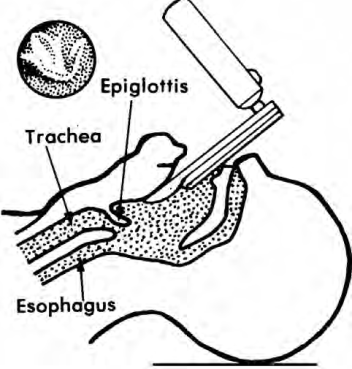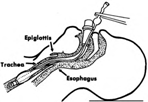|
Advantages of tracheal intubations:
Airway patency
Protects the airway
Maintains patency during positioning
Control of ventilation
ventilation over a long period of time
without intubation can lead to gastric distention and
regurgitation
Advantages of tracheal intubations:
Route for inhalation anesthesia and
emergency medications
N - Narcan
A - Atropine
L - Lidocaine
E - Epinephrine
|
 Complications of tracheal intubation:
Trauma to the lips, teeth, and soft
tissues of the airway.
Awareness
meticulous technique
Bronchial intubation
frequent complication
auscultation of the chest bilaterally
Complications of tracheal intubations:
Laryngospasm
common when extubation is done when the
patient is in a semiconscious state
extubation should be done in a
relatively deep anesthesia or when the protective laryngeal reflex
has returned
Postintubation hoarseness and sore throat
due to mechanical presence of the
tracheal tube
Preparation of Equipment
Assemble pharyngeal airways in assorted sizes
Nasopharyngeal
Oropharyngeal
Inspect laryngoscope for serviceability
Batteries
Light bulb
Blades; curved/straight (Macintosh or Miller)
Selection of laryngoscope blade (preference)
Macintosh is a curved blade whose tip is
inserted into the vallecula (the space between the base of the tongue and
the pharyngeal surface of the epiglottis). Most adults require a Macintosh
number 3 or 4 blade.
Selection of laryngoscope blade (preference)
Miller is a straight blade that is passed so
that the tip of the blade lies beneath the laryngeal surface of the
epiglottis. The epiglottis is then lifted to expose the vocal cords. Most
adults require a Miller number 3 blade.
Continue
to the PowerPoint Lecture...
From SFC Hill
Joint Special Operations Medical Training Center
In
Operational
Medicine 2001
Bureau of Medicine
and Surgery
Department of the
Navy
|


